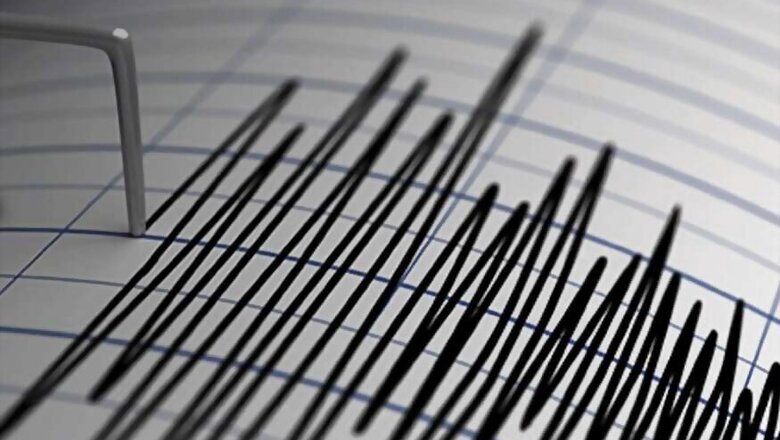
views
New Delhi: Since April the Delhi-National Capital Region (NCR) has recorded over 10 earthquakes, all below magnitude 5 on the Richter scale. In the middle of lockdown and Covid-19 pandemic, the likelihood of a big temblor hitting the national capital has got people in Delhi-NCR worrying. Scientists, however, said that these smaller earthquakes are not likely to be a precursor to a bigger quake.
Delhi and some parts of the NCR sit on a folded crustal ramp and these are bounded by two regional faults; the Mahendragarh-Dehradun Sub Surface Fault in the west and the Great Boundary Fault in East Delhi, as per the central government’s 2016 report on seismic hazard microzonation. Besides, other fault lines of consequence in the region are the Moradabad fault and Sohna fault. Scientists explained that even as Delhi falls in seismic zone IV which is classified as a severe zone, seismic activity in and around the city is not potent enough to lead to a large earthquake.
“Earthquakes cannot be forecast. But if we look into the past of Delhi and adjoining regions, there has not been any major earthquake whose epicentre was in Delhi. The quake on Wednesday whose epicentre was in Noida is likely to have happened due to sub-surface adjustments in the Moradabad fault,” said JL Gautam, head of operations at the National Centre of Seismology.
Kalachand Sain, the Director of Wadia Institute of Himalayan Geology, said that large seismic activity in the Himalayan region due to pushing of the Indian Plate underneath the Eurasian Plate is more likely to cause a bigger earthquake, as has been recorded in the past. These quakes, Sain said, will pose a bigger problem to Delhi’s structures than local adjustments in the sub-surface. Sain also cautioned that more investigation is needed into the faults that exist in and around Delhi to examine how they facilitate release of energy that is builds up in the Himalayan region.
“The earthquakes in Delhi-NCR, at this point, appear to be the manifestation of the release of the stress that must have accumulated in local faults and it can be considered that most of the energy has been released. Even as we cannot rule out an earthquake in Delhi-NCR whose magnitude could be more than 4, these recent events will not lead to a major event of magnitude 7-9,” Sain said.
The recent earthquakes are likely to have happened due to the local tectonic movements and we need to examine these quakes further. Study on this region is meagre, he added.
The faults in Delhi and neighbouring regions are classified as plate interiors, said Vineet Kumar Gahalaut, Scientist, National Geophysical Research Institute (NGRI). In plate interior regions, the collision happens within the plate unlike in the Himalayan region where two plates collide against one another. “The deformation of the crust in the plate interior is much slower compared to the Himalayan region and these interior plates are more rigid. There is limited understanding of plate interior regions and such multiple instances of earthquakes definitely necessitate an examination,” Gahalaut said.
The Kutch region, Narmada region and Godavari failed rift region are a few other examples of plate interior regions.
Past Earthquakes in Delhi and Neighbouring Regions
The 2016 Ministry of Earth Sciences report on Seismic Hazard Microzonation of NCT Delhi had stated that the 422 earthquake events in and around Delhi were recorded between 2005 and April 2012. “Of these, more than 90 per cent events are of magnitude less than 3.0, with shallow focal depth of less than 15km.
Delhi was also affected by the 1991 Uttarkashi earthquake which was of magnitude 6.4 on the Richter scale and the 1999 Chamoli earthquake of magnitude 6.8 on the Richter scale. Historically, the 1803 Mathura earthquake of magnitude 6.8, Bulandshahar earthquake of magntiude 6.7 and Faridabad quake of magnitude 6 were some of the worst ones to affect Delhi and neighbouring districts, the 2016 report shows.
The 1803 Mathura quake, in fact, reportedly caused damage to the Qutub Minar.
The report also mentions an earthquake in Gurgaon dating back to August 1960. The event was of magnitude 6 near Sohna and was felt as far as Kanpur and Jaipur. It led to property damage and injuries among Delhiites.
“The earthquake of October 10, 1956 is the largest instrumentally recorded earthquake near this (Moradabad) fault. This earthquake was felt in a very large area and was responsible for damage to buildings in which 23 persons perished in Bulandshahar and some were injured in Delhi,” the report said.




















Comments
0 comment